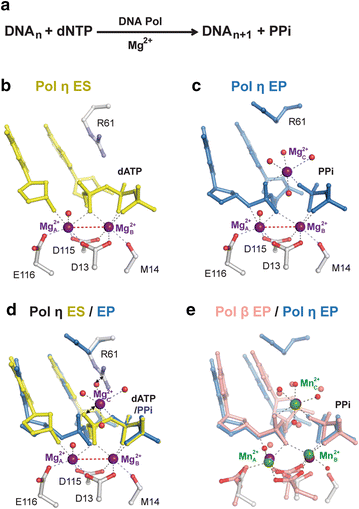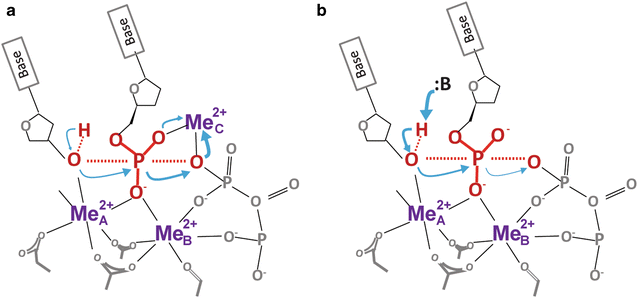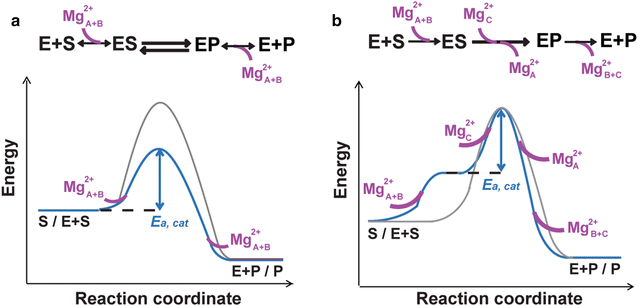A new paradigm of DNA synthesis: three-metal-ion catalysis
- PMID: 27602203
- PMCID: PMC5012070
- DOI: 10.1186/s13578-016-0118-2
A new paradigm of DNA synthesis: three-metal-ion catalysis
Erratum in
-
Erratum to: A new paradigm of DNA synthesis: three-metal-ion catalysis.Cell Biosci. 2017 Jun 20;7:32. doi: 10.1186/s13578-017-0159-1. eCollection 2017. Cell Biosci. 2017. PMID: 28649319 Free PMC article.
Abstract
Enzyme catalysis has been studied for over a century. How it actually occurs has not been visualized until recently. By combining in crystallo reaction and X-ray diffraction analysis of reaction intermediates, we have obtained unprecedented atomic details of the DNA synthesis process. Contrary to the established theory that enzyme-substrate complexes and transition states have identical atomic composition and catalysis occurs by the two-metal-ion mechanism, we have discovered that an additional divalent cation has to be captured en route to product formation. Unlike the canonical two metal ions, which are coordinated by DNA polymerases, this third metal ion is free of enzyme coordination. Its location between the α- and β-phosphates of dNTP suggests that the third metal ion may drive the phosphoryltransfer from the leaving group opposite to the 3'-OH nucleophile. Experimental data indicate that binding of the third metal ion may be the rate-limiting step in DNA synthesis and the free energy associated with the metal-ion binding can overcome the activation barrier to the DNA synthesis reaction.
Figures



Similar articles
-
Detection of Reaction Intermediates in Mg2+-Dependent DNA Synthesis and RNA Degradation by Time-Resolved X-Ray Crystallography.Methods Enzymol. 2017;592:283-327. doi: 10.1016/bs.mie.2017.03.022. Epub 2017 May 3. Methods Enzymol. 2017. PMID: 28668125 Free PMC article.
-
Capture of a third Mg²⁺ is essential for catalyzing DNA synthesis.Science. 2016 Jun 10;352(6291):1334-7. doi: 10.1126/science.aad9633. Science. 2016. PMID: 27284197 Free PMC article.
-
The structural basis for pyrophosphatase catalysis.Structure. 1996 Dec 15;4(12):1491-508. doi: 10.1016/s0969-2126(96)00155-4. Structure. 1996. PMID: 8994974
-
Kinetic Mechanism of DNA Polymerases: Contributions of Conformational Dynamics and a Third Divalent Metal Ion.Chem Rev. 2018 Jun 27;118(12):6000-6025. doi: 10.1021/acs.chemrev.7b00685. Epub 2018 Jun 4. Chem Rev. 2018. PMID: 29863852 Review.
-
Catalytic metal ions and enzymatic processing of DNA and RNA.Acc Chem Res. 2015 Feb 17;48(2):220-8. doi: 10.1021/ar500314j. Epub 2015 Jan 15. Acc Chem Res. 2015. PMID: 25590654 Review.
Cited by
-
In crystallo observation of three metal ion promoted DNA polymerase misincorporation.Nat Commun. 2022 Apr 29;13(1):2346. doi: 10.1038/s41467-022-30005-3. Nat Commun. 2022. PMID: 35487947 Free PMC article.
-
Non-nucleoside Reverse Transcriptase Inhibitors Inhibit Reverse Transcriptase through a Mutually Exclusive Interaction with Divalent Cation-dNTP Complexes.Biochemistry. 2019 Apr 23;58(16):2176-2187. doi: 10.1021/acs.biochem.9b00028. Epub 2019 Apr 5. Biochemistry. 2019. PMID: 30900874 Free PMC article.
-
Phosphate steering by Flap Endonuclease 1 promotes 5'-flap specificity and incision to prevent genome instability.Nat Commun. 2017 Jun 27;8:15855. doi: 10.1038/ncomms15855. Nat Commun. 2017. PMID: 28653660 Free PMC article.
-
The nature of the DNA substrate influences pre-catalytic conformational changes of DNA polymerase β.J Biol Chem. 2018 Sep 28;293(39):15084-15094. doi: 10.1074/jbc.RA118.004564. Epub 2018 Aug 1. J Biol Chem. 2018. PMID: 30068550 Free PMC article.
-
In crystallo observation of active site dynamics and transient metal ion binding within DNA polymerases.Struct Dyn. 2023 Jun 15;10(3):034702. doi: 10.1063/4.0000187. eCollection 2023 May. Struct Dyn. 2023. PMID: 37333512 Free PMC article.
References
-
- Sumner JB. The isolation and crystallization of the enzyme urease: preliminary paper. JBC. 1926;69:435–441.
-
- Laidler KJ, King MC. Development of transition-state theory. J Phys Chem. 1983;87:2657–2664. doi: 10.1021/j100238a002. - DOI
Publication types
LinkOut - more resources
Full Text Sources
Other Literature Sources
Research Materials

